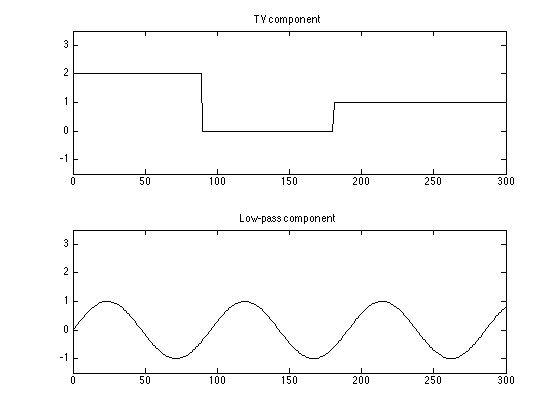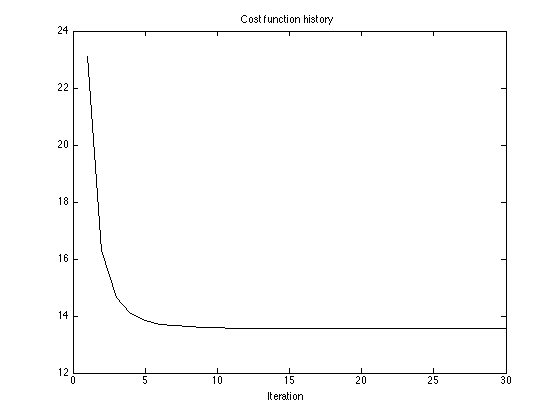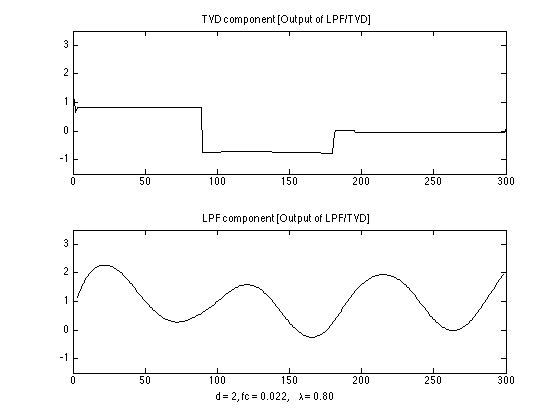LPFTVD_Example_1
This example illustrates the LPF/TVD algorithm: simultaneous low-pass filtering (LPF) and total variation denoising (TVD). The algorithm is based on majorization-minimization and fast solvers for banded linear systems.
Ivan Selesnick Polytechnic Institute of NYU 2012
Contents
Start
clear % close all printme = @(filename) print('-dpdf', sprintf('figures/LPFTVD_Example_1_%s', filename));
Create test signal
N = 300; % N : length of signal n = (1:N)'; s1 = 2*(n < 0.3*N) + 1*(n > 0.6*N); % s1 : step function s2 = sin(0.021*pi*n); % s2 : smooth function s = s1 + s2; % s : total signal ax = [0 N -1.5 3.5]; % ax : axis for plots figure(1) clf subplot(2, 1, 1) plot(s1) axis(ax) title('TV component') subplot(2, 1, 2) plot(s2) axis(ax) title('Low-pass component')

Create noisy signal
sigma = 0.3; % sigma : standard deviation of noise randn('state', 0); % Set state so example is reproducible noise = sigma*randn(N, 1); % noise : white zero-mean Gaussian y = s + noise; % y : noisy data figure(1) clf subplot(2, 1, 1) plot(y) axis(ax) title('Data'); printme('data')

Define high-pass filter H
The high-pass filter is H = A\B where A and B are banded matrices (sparse data type in MATLAB).
% Set filter parameters (fc, d) d = 2; % d : filter order parameter (d = 1, 2, or 3) fc = 0.022; % fc : cut-off frequency (cycles/sample) (0 < fc < 0.5); [A, B, B1] = ABfilt(d, fc, N);
LPF/TVD algorithm
Run the LPF/TVD algorithm to perform simultaneous low-pass filtering (LPF) and total-variation denoising (TVD).
lam = 0.8; % lam : regularization parameter Nit = 30; % Nit : number of iterations [x, f, cost] = lpftvd(y, d, fc, lam, Nit); % Run LPF/TVD algorithm % x : TVD component % f : LPF component txt_params = sprintf('d = %d, fc = %.3f, \\lambda = %.2f', d, fc, lam); err = s - x - f; err = err(d+1:N-d); % truncate NaNs. rmse = sqrt(mean(err.^2)); fprintf('LPF/TVD (RMSE = %.3f)\n', rmse); % txt = sprintf('LPF/TVD (RMSE = %.3f)', rmse); % disp(txt)
LPF/TVD (RMSE = 0.081)
Cost function history
Show the cost function history to verify the convergence of the algorithm.
figure(1) clf plot(cost) title('Cost function history'); xlabel('Iteration') printme('cost')

Display output of LPF/TVD algorithm
Set mean of x to zero for convenience of plotting
mx = mean(x); x = x - mx; f = f + mx;
Display LPF/TVD output
figure(2) clf subplot(2, 1, 1) plot(x + f) axis(ax) str = sprintf('Denoised signal [Output of LPF/TVD] (RMSE = %.3f)', rmse); title(str) xlabel(txt_params) printme('lpftvd')

Display the two components separately (low-pass and sparse derivative)
figure(2) clf subplot(2, 1, 1) plot(x) axis(ax) title('TVD component [Output of LPF/TVD]'); subplot(2, 1, 2) plot(f) axis(ax) title('LPF component [Output of LPF/TVD]'); xlabel(txt_params) printme('lpftvd_components')

Verify optimality condition
Verify that the result obtained from lpftvd function satisfies the optimality conditions. (The scatter points should lie on the 'sign' function.)
AAT = A*A'; g = B1'*(AAT\(B*(y - x))); % same as S'H'H(y - x) m = max(abs(diff(x))); figure(1) clf line([-m 0 0 m]*1.2, [-1 -1 1 1]*lam, 'color', 0.5*[1 1 1]) % sign function line(diff(x), g, 'marker', '.', 'linestyle', 'none', 'markersize', 10); % scatter points xlim([-1 1]*1.2*m) ylim([-1 1]*1.5*lam) ylabel('g = S H^T H(y - x)') xlabel('u = diff(x)') title('Optimality condition') printme('optimality')
